In this article, we will discuss the two most popular flooring options, Laminate Floor vs Engineered Wood. Choosing between them can be a daunting task for homeowners, so we will explore the key differences between them.


We’ll evaluate their composition, durability, cost, installation, maintenance, and overall aesthetics. By the end of this article, you will have a clear understanding of the pros and cons of each type of flooring.
In the end, you will be able to make an informed decision on the best option for your home. Let’s get started.
Composition
When it comes to Laminate Floor vs Engineered Wood, understanding their composition is essential in determining their durability, performance, and appearance.
Laminate flooring is composed of several layers, including a high-density fiberboard core, a photographic layer of wood grain or stone texture, and a top wear layer for protection. Engineered wood, on the other hand, consists of a thin layer of real hardwood veneer bonded to a sturdy plywood or composite base.
The materials used in laminate flooring make it more resistant to scratches and moisture, while engineered wood offers an authentic wood appearance that cannot be replicated. However, both options offer a range of styles, colors, and textures to match any design aesthetic.
Laminate Floor vs Engineered Wood: Composition Comparison Table


| Laminate Flooring | Engineered Wood | |
|---|---|---|
| Core Material | High-density fiberboard | Plywood or composite base |
| Top Layer | Photographic wood grain or stone texture layer with a wear layer on top | Real hardwood veneer layer |
| Aesthetic Appeal | A wide range of styles, colors, and textures available to match any design aesthetic | Authentic wood appearance that cannot be replicated |
| Durability | Resistant to scratches and moisture | – |
As shown in the comparison table, both laminate flooring and engineered wood offer unique benefits in terms of composition. While laminate flooring is more resistant to scratches and moisture, engineered wood offers an authentic wood appearance that cannot be replicated.
Durability
In terms of durability, both laminate flooring and engineered wood have unique characteristics that make them suitable for different types of environments. A major factor to consider when assessing durability is the ability of the material to resist moisture, scratches, and general wear and tear.
Laminate flooring is a highly resistant option that is particularly suitable for high-traffic areas due to its toughness and resilience. It is made of a compressed fiberboard core, which is then coated with a high-quality photographic image, followed by a finish layer to provide surface protection.
Engineered wood is also a durable option, however, it is less resistant to moisture and scratches than laminate flooring. It is made up of multiple layers of wood veneers that are glued together, which can expand or contract over time due to humidity levels. This makes it unsuitable for use in areas with high humidity or exposure to moisture.
To determine the lifespan of each type of flooring, it’s best to consult with the manufacturer’s warranty to understand how long the product is expected to last and under what conditions.
To summarize, laminated flooring is more durable and handles wear and tear better compared to engineered wood. However, engineered wood can still be a durable choice if it’s properly maintained and used in areas with minimal moisture and foot traffic.


Cost
One of the most significant factors in choosing between laminate flooring and engineered wood is cost. While both options come with upfront expenses, the long-term value may vary. Let us take a closer look at the cost factors associated with each option.
Laminate Flooring Cost
Laminate flooring is often an affordable option, with prices ranging from $1 to $7 per square foot. The cost factors to consider are the quality of the product, the thickness, and the design. Higher quality laminates with more authentic-looking designs and thicker boards can cost more upfront but may ultimately save you money in the long run as they tend to have longer lifespans.
Engineered Wood Cost
Compared to laminate flooring, engineered wood can be more expensive, with prices ranging from $4 to $13 per square foot. The cost varies depending on the type of wood used, the thickness of the boards, and the overall quality. However, despite its initial higher expense, engineered wood flooring may be a better investment in the long run. Its durability and lifespan can make it a better value, as it may not need to be replaced for many years.


In conclusion, while laminate flooring can be a more budget-friendly option, engineered wood may be a better investment due to its longer lifespan. However, it’s crucial to consider upfront costs and long-term value when making a decision.
Installation
When it comes to installation, laminate flooring and engineered wood have some key differences to consider.
Laminate floors are click-together floating floors that don’t require any glue or nails to lay down. They can be placed over existing subfloors like hardwood, vinyl, or concrete, subject to certain conditions. Their click-together design makes them relatively easy to install, and some DIY enthusiasts may even attempt to lay them on their own. However, when installing laminate floors, it’s important to note that they require a level subfloor. Any irregularities in the subfloor can cause the planks to buckle or budge over time, which can be undesirable. It’s also recommended to leave an expansion gap around the edges of the room.
On the other hand, engineered wood flooring is typically nailed or glued down. Unlike laminate, engineered wood can sometimes be sanded and refinished multiple times. However, engineered wood flooring installation can be more complicated than laminate. Installation methods can vary depending on the type of engineered wood planks chosen. Some may click together, much like laminate, but many need to be adhered to the subfloor with glue or nails. Achieving a level subfloor is just as important with engineered wood flooring, and adding a moisture barrier may be necessary to prevent the planks from warping. It’s generally recommended to use a professional installer to ensure a proper installation and avoid potential issues down the line.


Laminate Floor Installation
| Pros | Cons |
|---|---|
| Easier to install than engineered wood | Requires a level subfloor and expansion gap around the edges of the room |
| DIY-friendly for those with some experience | May need to be replaced completely if damaged or worn out |
| No need for glue, nails, or staples | Tends to be noisier underfoot than engineered wood |
Engineered Wood Installation
| Pros | Cons |
|---|---|
| Can be sanded and refinished multiple times | More complicated to install than laminate |
| Offers a wide range of installation options depending on the plank type | Requires a level subfloor and moisture barrier, if needed |
| Can last longer than laminate flooring | Generally more expensive to install |
While laminate flooring installation may be easier for some homeowners to pursue on their own, it’s important to remember that proper subfloor preparation is required to avoid issues down the line. On the other hand, while engineered wood installation may be more complicated, it can offer the added benefit of being sanded and refinished multiple times. It’s generally recommended to use a professional installer for both types of flooring to ensure the installation is done correctly and to avoid any problems with the overall longevity and performance of the floors.
Maintenance
Proper maintenance is a key factor to keep your flooring looking its best. Although laminate flooring and engineered wood have a different composition, both require regular cleaning and care to extend their lifespan.
Cleaning Methods
Cleaning laminate floors is straightforward, requiring a damp mop with a vinegar or ammonia-free cleaning solution. Avoid using soaking wet mops and steam cleaners, as the water can seep into the joints of the laminate and cause it to swell. On the other hand, cleaning engineered wood floors requires more attention because the surface is more susceptible to damage. Use a vacuum cleaner or broom to remove dirt and debris, followed by a damp mop with a cleaner that is specifically designed for hardwood floors.
Stains and Scratches
Laminate flooring has a hard, scratch-resistant surface that can withstand normal wear and tear. However, deep scratches and chips cannot be repaired and require planks to be replaced. Additionally, laminate flooring is prone to water damage, and standing water can cause the planks to warp. In contrast, engineered wood is more resilient against scratches and stains, but still requires protection against moisture. Spills and stains should be wiped up immediately to prevent them from settling into the wood and causing permanent damage.
Refinishing Options
If your laminate flooring has lost its shine or looks dull, it can be revitalized using a laminate floor refresher, or a commercial cleaner made specifically for its surface. Refinishing options for laminate floors are limited, as the surface is not real wood and cannot be sanded or stained. On the other hand, engineered wood floors can be sanded and refinished several times over their lifespan, making them a more versatile and long-lasting option.


Aesthetics
The appearance of your flooring can have a significant impact on the overall visual appeal of your home. When it comes to choosing between laminate floor vs engineered wood, aesthetics play an important role. Both of these types of flooring offer a wide range of textures, colors, and styles, providing ample options to match your design preferences.
However, laminate flooring is known for its versatility in mimicking the look of real wood or stone, while engineered wood is made from real hardwood, giving it a more authentic appearance.


When it comes to texture, laminate flooring often offers a smoother and more consistent appearance, while engineered wood can have a more natural, organic look with visible grains and knots.
In summary, both Laminate Floor vs Engineered Wood offer a variety of aesthetic options to fit your design style. The choice between these two options mostly depends on personal preferences and the overall design of the room. It is best to consider all factors, including the durability, cost, and installation requirements, before deciding on the flooring option that fits your aesthetic preferences.
Conclusion
After considering the key factors of laminate flooring and engineered wood, we recommend that you choose the option that best suits your unique needs and preferences.
If you prioritize cost-effectiveness and durability, laminate flooring may be the better choice. It’s available at a variety of price points, easy to install, and resistant to scratches and wear. However, it may not be as long-lasting as engineered wood, and its aesthetic appeal may be less authentic.
On the other hand, if you’re looking for a flooring option that combines style and durability, engineered wood is a fantastic choice. It’s composed of genuine wood layers, giving it an authentic look and feel. It’s also more resistant to moisture and has a longer lifespan than laminate flooring. However, it can be more expensive, requires professional installation, and may be less resistant to scratches.
Ultimately, the choice between laminate flooring and engineered wood depends on your personal preferences, budget, and lifestyle. We advise that you carefully consider the factors discussed in this article before making your final decision.
Thank you for reading. We hope this article has provided valuable insights into the differences between laminate flooring and engineered wood and assisted you in making an informed decision regarding your home’s flooring needs.
Thanks For the Great Attention!
Also, Read,
Laminate Flooring Installation Guide
Best Laminate Flooring Materials
FAQ
What is the difference between Laminate Floor vs Engineered Wood?
Laminate flooring is made from a high-density fiberboard core topped with a photographic layer that mimics the look of wood. On the other hand, engineered wood is composed of multiple layers of real wood veneer glued together with a plywood core.
Which option is more durable, Laminate Floor vs Engineered Wood?
While both options are relatively durable, engineered wood tends to have a longer lifespan and better resistance to moisture, scratches, and wear compared to laminate flooring.
What are the cost differences between Laminate Floors vs Engineered Wood?
Generally, laminate flooring is more affordable than engineered wood in terms of upfront costs. However, it’s important to consider the long-term value and potential maintenance expenses for a more accurate cost assessment.
How do the installation processes compare between Laminate Floor vs Engineered Wood?
Laminate flooring is known for its ease of installation, often utilizing a click-lock system that doesn’t require extensive adhesive or nails. On the other hand, engineered wood typically requires professional installation due to the need for proper subfloor preparation and adhesion.
What is the maintenance required for Laminate Floor vs Engineered Wood?
Laminate flooring is relatively low-maintenance, requiring regular sweeping and occasional damp mopping. Engineered wood may require more care, including preventive measures against moisture damage and periodic refinishing to maintain its appearance.
How do the aesthetics of Laminate Floor vs Engineered Wood compare?
Both options offer a wide range of styles, colors, and textures to suit various design preferences. Laminate flooring can replicate the look of various wood species convincingly, while engineered wood provides the authentic beauty of real wood grains.
Based on your analysis, which option would you recommend for home flooring?
Based on the factors discussed, we recommend considering engineered wood for its superior durability, longevity, and authentic wood appearance. However, individual preferences, budget constraints, and specific circumstances should also be taken into account when making a final decision.



Thank you for the auspicious writeup It in fact was a amusement account it Look advanced to more added agreeable from you By the way how could we communicate